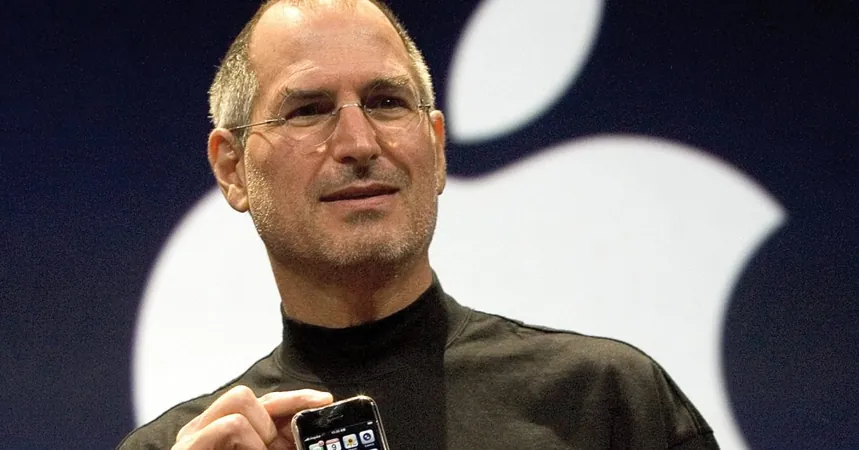
Is the iPad on Its Last Legs? The Rise of Foldable iPhones Could Change Everything!
2025-03-31
Author: Noah
When Steve Jobs revolutionized the tech world by introducing the iPad, he famously labeled it as a “third category of device,” distinctively positioned between a smartphone and a laptop. For years, this device has held its ground by excelling in tasks like light web browsing, media consumption, and email management. However, a looming question arises: what happens to the iPad now that foldable iPhones are on the horizon, potentially integrating the best features of both smartphones and tablets?
The Future of Apple’s Device Landscape
The anticipated rollout of Apple's first foldable iPhone has got tech enthusiasts buzzing with excitement. Imagine an “iPhone Fold” that offers the utility of an iPad mini while fitting snugly in your pocket. Personally, I have fond memories of using the iPad mini, but my transition to the iPad Pro meant saying goodbye to the compact device. Now, my M4 iPad Pro essentially resembles a laptop, relegating it to less portable tasks. What I wouldn’t give to revisit that portability!
Steve Jobs proposed that for the iPad to justify its existence, it must outperform both laptops and smartphones for certain functions. While some users, like myself, still depend on the iPad as a primary computing device, others view it simply as a tool for casual entertainment.
As smartphone displays grow, and laptops become sleeker and more mobile-friendly, the iPad is facing stiffer competition. With the impending launch of foldable iPhones, the battleground for consumer preference is set to shift dramatically.
The iPad: A Niche Player in a Competitive Market
Despite fears for the iPad’s future, it’s not heading for extinction anytime soon. The first iPhone Fold will likely appeal to a niche audience, considering its anticipated price tag of around $2,000—allowing the more budget-friendly iPad, starting at $349, to continue thriving in the market.
Looking five years ahead, however, could tell a different story. If foldable devices capture widespread consumer interest, Apple may diversify its lineup further, with various foldable iPhone models emerging at competitive price points. The expected specs for next year’s iPhone Fold anticipate a 5.5-inch outer display and a 7.8-inch inner screen—mimicking the size of the iPad mini when unfolded yet more compact when closed.
Historical trends indicate that large iPhones have consistently attracted customers. It wouldn't be shocking to see multiple foldable iPhone variations roll out, gradually replacing traditional iPhones and potentially encroaching on the iPad’s territory.
As technology continues to evolve, the iPad might find its place as a budget-friendly option or could evolve into a premium, large-scale foldable format. Yet, for an average consumer, the need for an iPad could very well diminish as foldable iPhones begin to take center stage in Apple’s product ecosystem.
A Change in Consumer Needs?
When Jobs was at the helm, that “third device” held a significant purpose. However, with foldable smartphones on the rise, the landscape is ripe for change. While I have always cherished the iPad, it seems we may soon be witnessing the dawn of its natural conclusion in our daily tech lives.
Do you think the impending arrival of foldable iPhones will spell the end for the iPad? Share your thoughts—your opinion matters!









 Brasil (PT)
Brasil (PT)
 Canada (EN)
Canada (EN)
 Chile (ES)
Chile (ES)
 Česko (CS)
Česko (CS)
 대한민국 (KO)
대한민국 (KO)
 España (ES)
España (ES)
 France (FR)
France (FR)
 Hong Kong (EN)
Hong Kong (EN)
 Italia (IT)
Italia (IT)
 日本 (JA)
日本 (JA)
 Magyarország (HU)
Magyarország (HU)
 Norge (NO)
Norge (NO)
 Polska (PL)
Polska (PL)
 Schweiz (DE)
Schweiz (DE)
 Singapore (EN)
Singapore (EN)
 Sverige (SV)
Sverige (SV)
 Suomi (FI)
Suomi (FI)
 Türkiye (TR)
Türkiye (TR)
 الإمارات العربية المتحدة (AR)
الإمارات العربية المتحدة (AR)